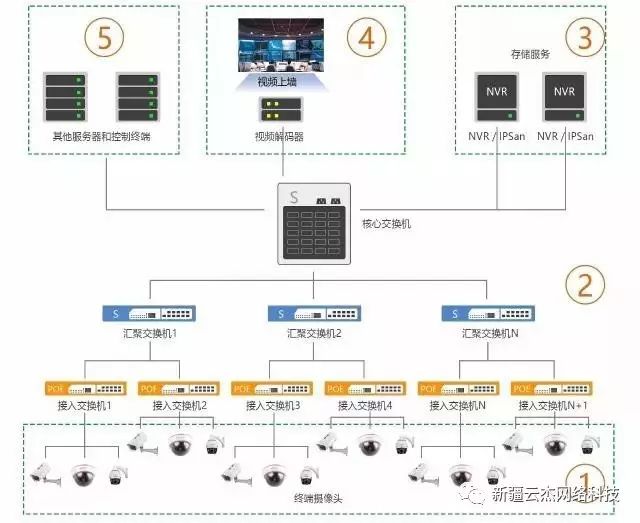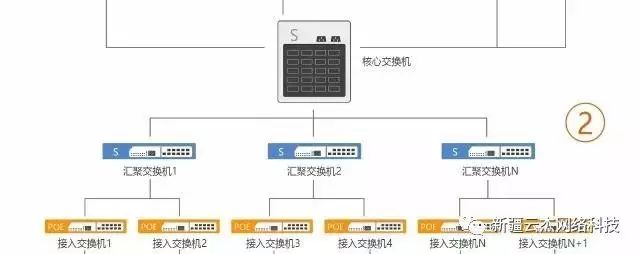
The above image divides the security monitoring video network into five parts. This article will interpret the devices and precautions involved in each area one by one, providing convenience for colleagues in the security industry.

① Access Terminal Area: Such as PTZ cameras, dome cameras, bullet cameras, etc.
· The common single-channel transmission rate for cameras is generally between 4-16M; mainstream 2-megapixel 1920x1080P – bit rate around 4M; mainstream 4-megapixel 2560x1440P – bit rate around 8M;
· The camera interface rates are 10M, 100M, and 1000M; when selecting switches, pay attention to the port rate;
· Cameras have two power supply modes: POE and non-POE, with power consumption ranging from a few watts to over ten watts; outdoor large PTZ cameras >30 watts; POE switches can be selected as needed, and attention should be paid to the total output power of the switch.

② Network Transmission Area: Switches and other devices with transmission media
· Generally, there is one core switch located in the central machine room, with multiple aggregation and access switches distributed in various buildings’ weak current wells based on environmental conditions;
· Considering factors such as the number of floors and distances between buildings, access layer switches usually require electrical ports with optical port uplinks; core switches and aggregation switches mostly use optical ports; equipment selection must pay attention to port numbers, port types, bandwidth, switching capacity, and port cache parameters;
· The transmission media include network cables and optical fibers; use network cables for transmission within 100 meters, and optical fibers for long-distance transmission;

③ Storage Server Area: IPSan or NVR, etc.
· IPSan servers are used for large-scale networks, while NVR is chosen for small scenarios;
· Common specifications include 8, 16, 32, or 64-channel cameras, with RJ45 ports;
· Usually located in the central machine room, connected to the core switch. If there are insufficient ports on the core switch, a separate switch can be connected, and when the total traffic of cascading ports exceeds 600M, consider using 10G cascading;
· It occupies a large bandwidth, and each video stream must ensure real-time performance.

④ Video Display Device Area: Decoders, wall-mounted large screens, etc.
· Most are connected to the core switch via electrical ports (RJ45); if ports are insufficient, a separate switch can be connected;
· It occupies a large bandwidth; in some projects, it is necessary to display data from all cameras in real-time, so port quantity and bandwidth must be considered.

⑤ Other Servers and Terminal Control Device Area: Such as streaming media servers, management clients
· Streaming media servers are common in large networks, generally with 2 RJ45 ports for master-slave backup, with all data traffic passing through the streaming media server, which copies N copies for distribution, occupying a large bandwidth;
· Management clients serve as hosts to manage various submodules, with smaller bandwidth usage, RJ45 ports.

Long press to recognize the QR code for more exciting content 